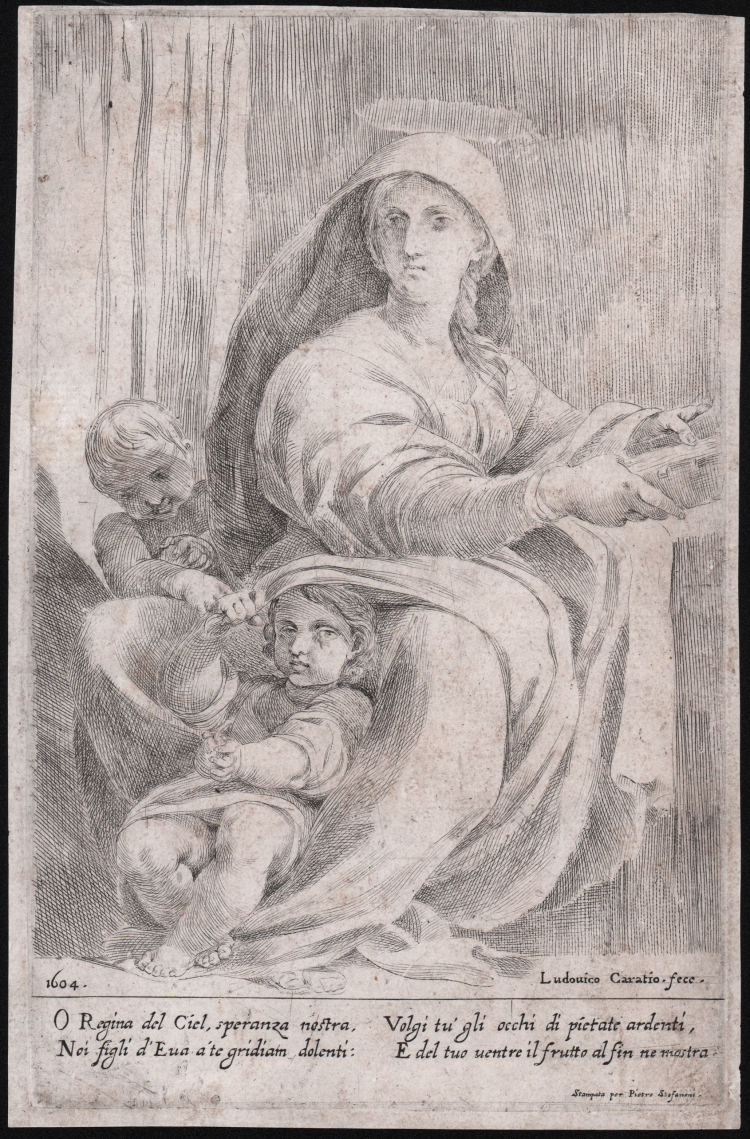




| Reference: | S47181 |
| Author | Ludovico CARRACCI |
| Year: | 1604 |
| Measures: | 130 x 210 mm |



| Reference: | S47181 |
| Author | Ludovico CARRACCI |
| Year: | 1604 |
| Measures: | 130 x 210 mm |
Madonna and Child with St John; the Virgin Mary seated at a table turned slightly to left and holding an open book, with the infant Christ seated at her feet and the infant St John standing behind to left, leaning on her knee.
Etching and drypoint, circa 1602-1604, signed on plate at lower right.
Second state, finished with etching and published by Pietro Stefanoni.
Diana De Grazia Bohlin, in her study of the Carracci engravings (1979, pp. 486-488), suggests a date between 1602 and 1604 for the execution of the engraving by Ludovico. The date 1604, printed in the second state of the print, in fact, would correspond only to the publication date of the sheet by the publisher Pietro Stefanoni, originally from Vicenza and settled in Rome. There is an example of the drypoint, that can be considered a first issue for the final work, preserved in Milan among those of the Resta Codex of the Biblioteca Ambrosiana.
Ludovico Carracci (Bologna, 21 April 1555 – Bologna, 13 November 1619) was an Italian painter, cousin of the brothers Agostino and Annibale Carracci. Born in Bologna in 1555, he trained with Prospero Fontana, traveling to Florence, Parma, Mantua, Venice and coming into contact with Camillo Procaccini. He is the oldest member of the Carracci family, cousin of Annibale. He prefers religious painting aimed at moralization and as a devotional stimulus.
Good work, printed on contemporary laid paper, with thin margins or trimmed to the copperplate, in good condition.
Bibliografia
Bartsch, Le Peintre graveur (XVIII.25.3); De Grazia, Carracci, pp. 486-488.
Ludovico CARRACCI (21 Aprile 1555 – 13 Novembre 1619)
|
He was an Italian painter, etcher, and printmaker who helped reinvigorate Italian art after Mannerism by founding an academy in Bologna in 1585. Along with his cousins Annibale Carracci and Agostino Carracci he is considered to be the founder of the Eclectic School of painting of the late 16th century in Italy.
He was born and died in Bologna. Ludovico apprenticed under Prospero Fontana in Bologna and traveled to Florence, Parma, and Venice before founding the Accademia degli Incamminati. This academy was responsible for training some of the more notable artsists of the next generation, including Guido Reni and Domenichino, with studies focused on observation of nature, study of poses from life, and bold scale in drawing figures. Ludovico specifically helped train Giacomo Cavedone from 1595 onward, when the latter became Caposindaco of the Accademia degli' Incamminati.
Ludovico's own are works are characterized by a strong mood envoked by broad gestures and flickering light that give a sense of spiritual emotion. His style would influence several Italian Baroque painters.
|
Ludovico CARRACCI (21 Aprile 1555 – 13 Novembre 1619)
|
He was an Italian painter, etcher, and printmaker who helped reinvigorate Italian art after Mannerism by founding an academy in Bologna in 1585. Along with his cousins Annibale Carracci and Agostino Carracci he is considered to be the founder of the Eclectic School of painting of the late 16th century in Italy.
He was born and died in Bologna. Ludovico apprenticed under Prospero Fontana in Bologna and traveled to Florence, Parma, and Venice before founding the Accademia degli Incamminati. This academy was responsible for training some of the more notable artsists of the next generation, including Guido Reni and Domenichino, with studies focused on observation of nature, study of poses from life, and bold scale in drawing figures. Ludovico specifically helped train Giacomo Cavedone from 1595 onward, when the latter became Caposindaco of the Accademia degli' Incamminati.
Ludovico's own are works are characterized by a strong mood envoked by broad gestures and flickering light that give a sense of spiritual emotion. His style would influence several Italian Baroque painters.
|